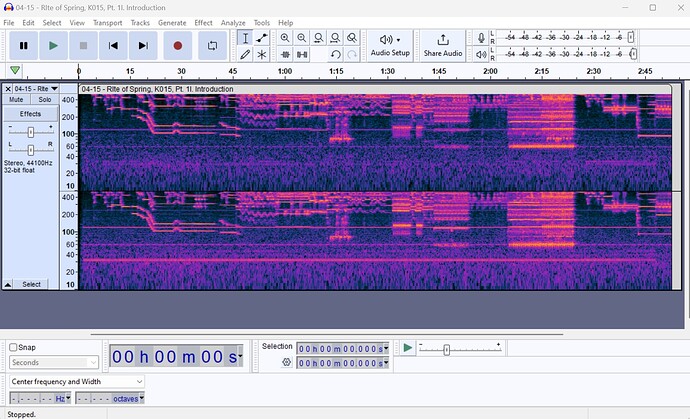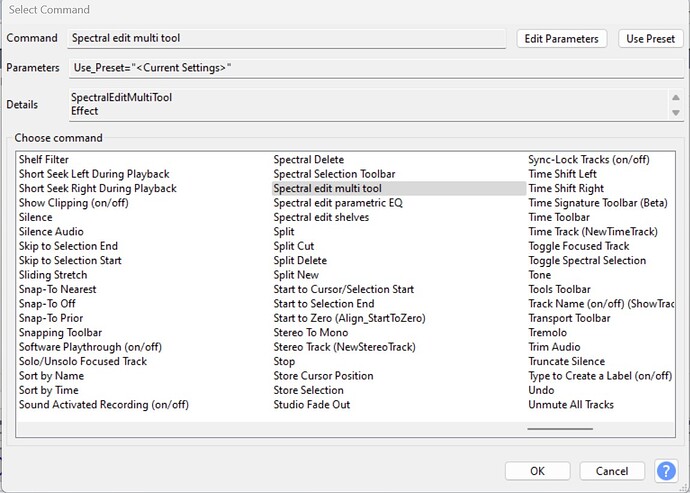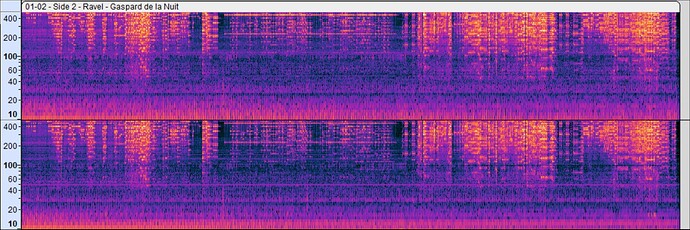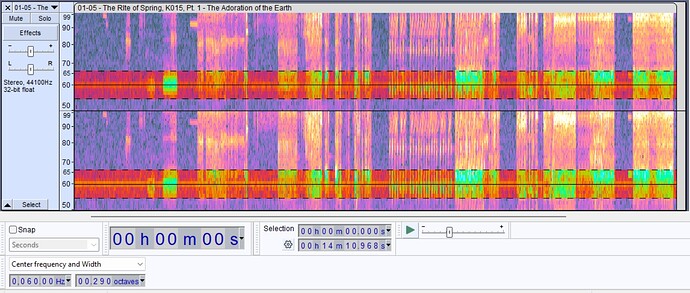I had posted in this thread before. Thanks to all for the help. This time around I am trying to apply an identical multi spectrum tool effect to 14 different files (all movements from sacre to printemps, this time separated into 14 instead of 2). So I am looking to replicate the processing I do on the first file to the other files. Is there any way to do this?
I did think of joining the files into one and then separating them again after processing, but this did not strike me as ideal.
Are you familiar with Macros? Macros - Audacity Manual
No, I am not familiar with audacity macros, but I have used macros in other prorams.
I looked at the macro page and found the spectral multi edit tool:
However I could not figure out how to use the parameters.
So with 14 files, it is going to be difficult to use the graphic interface. I am thinking your best results are to use the underlying low-pass, high-pass, and notch filters. For details, see: Spectral Edit Multi Tool - Audacity Manual
Thanks, this is what I would like to do:
- determine the parameters (center frequency, filter width) using the first file. I think four filters at 30, 60, 120 and 180Hz should be sufficient
- define four presets using these parameters
- define a macro that runs the four presets
The problem is that I have no idea how to define the presets for the spectral multi edit tool.
Maybe @steve has some hints?
Some of the musical notes are very close to the mains frequencies.
Applying a notch filter will take out the musical notes too.

Steve’s “hum remover” plugin may cause less collateral damage:
it has a threshold setting so will only be active when the volume of the music is low … Hum removal plug-in
Thanks @Trebor
I have done two runs, one with the spectral multi edit tool and one with the hum remover. It seems to me that the hum remover eliminates more of the spectrum than the (judiciously applied) spectral multi edit tool.
Multi edit tool (full 21 minutes):
Hum remover: (first eight minutes):
Listening to the two samples, the spectral edited one sounds fuller to me. It is true however that the hum remover leaves more of the the music intact when the volume is higher. Now if the filter bandwidth of the Hum Remover were adjustable, we might have the ideal tool. The Hum Remover is so easy to use that one could simply try different bandwidths to achieve the optimum degree of hum removal that just does away with the intrusive noise without damaging the music unnecessarily. Not all hums are created equal.
I have been doing quite a bit of tinkering with hum remover and spectral multi edit tool yesterday on these two recordings:
Dorati / Minneapolis, Stravinsky, Sacre du Printemps (bad 60Hz Hum, astonishing for a Mercury Living Presence recording)
Michael Studer, Gaspard de la Nuit (on Legacy Box) (Claves used a vinyl rip for the Legacy Box. The rip has a bad 50Hz hum)
My conclusions (and wishlist for Hum Remover) are as follows:
- The width of the hum bands is not the same for each recording. It would be good to make the width of the filter adjustable
- The center frequency of the fundamental (50Hz or 60Hz) is not always exactly at the round number. The hum on the Dorati is centered around almost 61Hz. I would be good to have a tool to exactly determine the center frequency and adjust the filter accordingly
- In both cases I noticed subharmonics at 12.5 / 25 and 15/30Hz. The lowest does not need to be filtered, but it would be nice to be able to eliminate the 25 or 30Hz
Big thanks to @steve for the wonderful Hum Remover!
Some have a 50Hz fundamental others have 60Hz.
Are you sure you selected the correct one on the hum remover plugin ?.
The spectrogram looks like 50, 100,150Hz ,… have been notched
Previously you mentioned “60, 120 and 180Hz” were required.
I edited my last post to give more details of the two recordings I worked on
Power stations regulate the mains frequency extremely accurately (accurate enough for clocks to use as their “pendulum” timing signal). However, a recording may run a bit fast or a bit slow, which will shift all pitches up or down a bit. If you find that the base hum frequency is not exactly 50 Hz or 60 Hz, then the most likely explanation is that the recording is playing a bit too fast or too slow. One solution for this problem would be to use Audacity’s “Change Speed” effect to correct the playback speed. This is arguably the best solution as the recording will then play at the speed and pitch of the original.
An alternative solution is, as you suggested, to adjust the centre frequency of the base filter frequency (all additional notches will change proportionally, so only the base (50 / 60 Hz) needs to be specified). To do this, open the plug-in in a plain text editor (such as NotePad++) and change the lines:
;control basef "Select Region" choice "Europe (50Hz),USA (60Hz)" 0
;control odd "Number of odd Harmonics" int "" 20 0 200
;control even "Number of even Harmonics" int "" 1 0 20
;control thresh "Hum Threshold Level(0 to 100%)" real "" 10 0 100
(setq basef
(case basef
(0 50)
(1 60)))
to:
;control basef "Root frequency (Europe 50Hz,USA 60Hz)" real "" 50 40 70
;control odd "Number of odd Harmonics" int "" 20 0 200
;control even "Number of even Harmonics" int "" 1 0 20
;control thresh "Hum Threshold Level(0 to 100%)" real "" 10 0 100
Thanks @steve for the input. I think I will do a pitch corrected and de-hummed version of the Dorati.
Looking at @Trebor 's link above, the points I raised seem to have been discussed in depth and thoroughly optimized. Impressive what this plugin can do re. thresholds and transient handling. Great stuff, thanks.
I slowed down the Dorati by 0.8% and the center frequency of the primary hum is now exactly at 60Hz. Great!
This topic was automatically closed after 30 days. New replies are no longer allowed.




